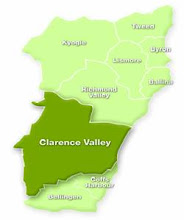On Thursday 1 December 2016 Clarence Valley Council held a public meeting on the subject of its asbestos removal strategy during site remediation prior to re-development of the site as a 'super depot'.
Asbestos removal will reportedly add an est. $2.5 million to the re-development $13.3 million cost.
The Daily Examiner, 5 December 2016, Clarence Valley Council depot site plan
Inquiry needed
Last night I attended a meeting at the Clarence Valley Council chambers, where the public was invited to be updated about the asbestos that has been uncovered at the site of the new council depot in Tyson St.
The overwhelming emotion at the meeting was one of anger, as council's director of works attempted to explain away what many see as criminal culpability.
Last year, council management was warned by a former employee that over a long period of time broken asbestos material had been buried at the site. However, rather than properly address the issue, council opted to deny there was any problem, accusing those who spoke up on the matter of being trouble-makers, scaremongers and liars.
In an attempt to quell rising concern, council instructed a firm of specialists to undertake investigations at the site. However, those instructions were to test samples from stockpiles, omitting any request to search for buried material.
Of course nothing was found, which allowed council to release a media statement which your newspaper reported (March 8), under the banner headline "Council depot site clear of asbestos".
That story contained the unequivocal statement that: "Further testing of the site has reinforced earlier findings saying it poses no risk from asbestos."
Ultimately, of course, some two weeks after excavation work had commenced, asbestos was uncovered, and during those two weeks dust was observed rising from the works, while high school students carried on activities as usual just across the fence. Nearby residents also reported the dust settling on their homes and yards.
The general public learned of the asbestos discovery with the release of papers for council's November meeting, where we read the extraordinary admission that, "A quantity of asbestos containing material was always expected to be encountered on-site" - finally acknowledging that they knew it was there all the time.
The acknowledgement that they deliberately misled the public, potentially exposing residents and many hundreds of students to deadly asbestos is, in my opinion, criminal.
After discovering asbestos at the site, workers began sieving and stockpiling what the EPA later confirmed is contaminated material. The fact that the EPA didn't inspect the site until almost two weeks after the asbestos was uncovered should also be investigated.
During those two weeks, there was no public statement made, no warning signs were erected, and contrary to assurances by council that nearby property owners and the high school had been told, many residents claimed they had received no such advice.
An assurance at the meeting that air quality is now being monitored, and that levels of whatever is floating around in the air are within guidelines, is hardly comforting, and there was no explanation of what particulate matter is being inhaled by those unfortunate enough to live or study in close proximity to the works.
One thing is certain, that anger will remain until digging up more polluted material is halted, the contaminated material is safely removed as required under the law, and a full inquiry held into how this whole shameful debacle was ever allowed to occur.
John Edwards
WORK on the Clarence Valley Council's $13 million super depot should stop immediately following the discovery of about 900kg of bonded asbestos on the site, say South Grafton residents.
At a public meeting on Thursday, called to discuss the issue, South Grafton resident Mark Butler said work should cease until further extensive testing on the site was done.
Mr Butler, who can see the depot 500m from his house in Moorehead Dr, said there needed to be deep core drilling of the entire site to discover the amount of asbestos that had been dumped on the site.
He described the initial testing as flawed because it was only done on selected parts of the site.
"Basically the council was saying drill here, drill there and, when they didn't find anything, they went ahead with it," Mr Butler said.
"But anecdotally lots of people knew there had been asbestos dumped at the site for more than 40 years.
"And now they've been proven right."
Mr Butler said the council should consider closing the site and completely sealing it, if it turned out there was more asbestos there than had been uncovered.
"Basically (the) council does not know what's there and, until they do, they should stop work and do more testing to find out.
"There's always been problems with the way the council pushed this depot through, but we've got to this point.
"Now they have to make sure what they do from now on does not create a medical emergency."
Mr Butler was critical of the way the council ran the public meeting, but said it did give residents a chance to have their say.
"The feeling I got was the council was trying to control it and tried to shut down any difficult questions," Mr Butler said.
Clarence Valley Mayor Jim Simmons was at the meeting and shared the concerns of residents, especially the worries about the proximity to South Grafton High School.
"At least we should look at stopping work until the start of the school holidays," Cr Simmons said.
The mayor was also surprised to learn the contractors, Hutchinsons Builders, had not installed air monitoring stations beyond the boundaries of the site on the corner of Rushforth Rd and Tyson St.
"I don't understand why they haven't done that," he said.
However, Cr Simmons was confident the contractors had the expertise to deal with the find.
Cr Simmons said the absence of the Environmental Protection Agency from the meeting had concerned him.
"I understand they had their reasons ... but I plan to get in contact with them," he said.
He was also surprised spokespeople from other government agencies, like WorkSafe, did not have more input at the meeting.
The mayor said the council owned the site and was obliged to remediate it.
"We would have had to fix it up whether or not there was a depot going on it," he said.
"There was a lot of emotion at that meeting, perhaps rightly so.
"Council needs to address their concerns about the asbestos on the site and also the dust which is blowing onto the properties."
BACKGROUND
WHAT IS BONDED ASBESTOS?
When asbestos fibres are bonded to another material, such as a cement or resin binder, it is known as bonded asbestos. It cannot be crumbled, pulverised or reduced to a powder by hand pressure when dry. Common uses in buildings include: flat (fibro), corrugated or compressed asbestos-cement (AC) sheeting; water, drainage and flue pipes and floor tiles.
If fire, hail, or illegal water blasting damages bonded asbestos, it may become friable asbestos material. A WorkCover licensed friable asbestos removalist must always carry out the removal of friable asbestos. They must also obtain a site-specific permit from WorkCover to carry out this type of work.
A WorkCover asbestos licence is required to remove 10 square metres or more of bonded asbestos (the size of a small bathroom). The reduction will result in more situations where a licence is required to remove bonded asbestos in NSW. The requirements for friable asbestos are unchanged….
A licence holder with a bonded asbestos removal licence can remove any amount of bonded asbestos provided they notify WorkCover at least seven days before commencing work. Bonded asbestos licence holders are not allowed to remove, repair or disturb any amount of friable asbestos.
The map provided to John
Edwards, which purports to be a representation of a map given to Clarence
Valley Council (CVC) by a former employee, who raised concerns that broken
asbestos pipes were dumped within the top red circle and in other areas (not
marked) at the site of the new CVC depot at South Grafton. Image: Contributed.
Clarence Valley Council
(CVC) has released a map that marks where asbestos was allegedly buried at the
site of the new ‘super’ depot under construction at Tyson Street, South
Grafton.
The Clarence Environment Centre’s John Edwards was given the map after an
appeal against CVC’s rejection of his formal GIPA (Government Information
(Public Access)).
A former employee alerted the council, last year, regarding his concerns that
fill placed at the site following the decommissioning of the sewerage treatment
plant (STP) may have included broken asbestos pipes.
The man told the Independent that he had given the original map to council; and
his main concern was the STP’s former sludge lagoon, which is marked on the map
given to Mr Edwards.
The former employee said the lagoon was filled over an 18-month to two-year
period in the late 1980s or early 1990s.
He said many truckloads of fill, which may have included broken concrete
asbestos pipes, building waste and other rubble, were put into the hole, which
was then covered with “two to three foot of top soil”…..
Looking at the various public documents – the site’s remediation action plan
and supplementary soil investigations prepared by consultants WSP Parsons
Brinckerhoff – it’s not clear where or how deep test holes/pits were dug.
A letter and map advising of supplementary soil investigations does not appear
to concur with an email (obtained via Mr Edward’s GIPA) from the council’s
water cycle manager, Greg Mashiah, to WSP Parsons Brinckerhoff.
Mr Mashiah’s email requests that “four additional test pits to be sampled; 2 in
each circle”, which are marked in red with a cross on the supplied map – the
one beneath the ‘former sludge pond’ was concerned with possible buried jars of
mercury…..
















